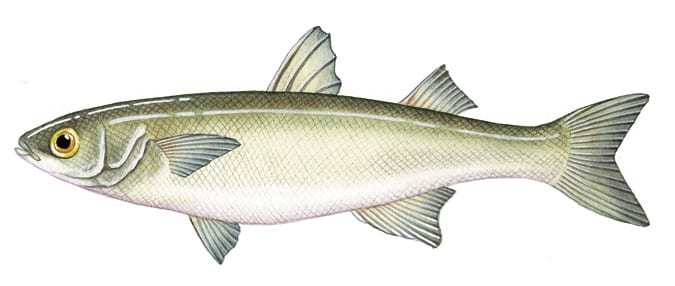Genus Mugilidae
Description
Yellow-eye mullet are silvery in colour with a greenish grey back. The dorsal fins are small and set well back along the body. The tail is forked and as the name suggests the eye is a bright yellow colour.
Distribution
Yellow-eye mullet are most common in estuaries and sheltered waters such as boat harbours. They congregate around structures such as piers and wharfs which offer shelter. Yellow-eye mullet are also commonly found in the shallow water of most coastal beaches.
Size
Yellow-eye mullet are a relatively small species of fish with most fish caught being less than 400 g in weight. Fish of 700 g of more are caught occasionally and these are considered to be large specimens.
Fishing techniques and tackle
Yellow-eye mullet respond extremely well to berley consisting of stale bread soaked in water with a small amount of tuna oil added to it. A very effective technique is to use a long telescopic rod (with no reel) to which a length of line is tied. One or two small (size 10- 12) long-shank hooks are presented beneath a small float. A standard spinning rod can also be used with a light line and a hook presented a metre or so beneath a quill float. Another technique that is productive is to use a paternoster rig and retrieve it very slowly.
Baits
Mullet can be caught on a variety of baits including very small pieces of chicken flesh, whitebait, prawn and pipi. Another effective bait is bread dough, to which can be added flavour and scent enhancers such as tuna oil, curry powder, stock cubes or cheese.
Locations
Yellow-eye mullet can be caught from most of the piers in the Port Phillip region and are found in all of the estuaries such as the Patterson, Barwon and Maribyrnong Rivers. A run of larger mullet quite often appear in the Werribee River during winter and early spring.
Sustainable fishing techniques
- Hook damage is the most significant cause of fish dying after being released. Deep-hooked (gills, gut) fish are far less likely to survive.
- Fish with a tight line so that fish are less likely to swallow the hook.
- Increase the size of your hooks to prevent small fish swallowing them.
- Avoid suspending fish on the hook.
- Fish hooked in the mouth or lip have the best chance of survival.
- Remove the hook with long nosed pliers.
- If you can’t see the whole hook protruding from the mouth of the fish don’t try and remove it.
- Cut the line and release the fish.
- Wet your hands before handling the fish.
- Avoid touching the gills and eyes.
- Return the fish as quickly as possible.



